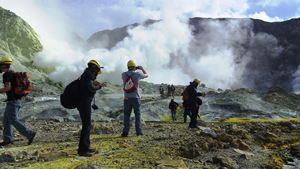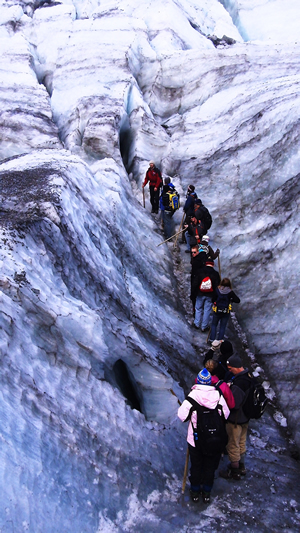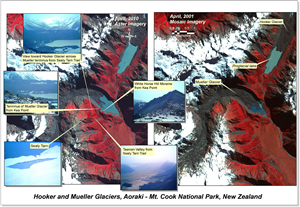In New Zealand, Earth Science Students Map Geologic Features
New GIS and GPS Tools Capture Precision Data
Highlights
- Tight correlation between GPS and GIS speeds up the geologic mapping process.
- Enhanced GPS field capture capabilities help students visualize geologic processes.
- Teaching students with the latest technology prepares them for the workforce.

University of Dayton geology students exploring the crater of White Island (Whakaari in Maori), an active andesite strato-volcano situated 48 km off the east coast of the North Island of New Zealand, in the Bay of Plenty (image courtesy Allen McGrew).
With the advent of GIS technology, new tools are available to students for mapping and interpreting surface and subsurface geologic formations. Concurrently, handheld GPS receivers provide a fast and accurate method for capturing precise location data. However, capturing structural geologic data, such as pitch, strike, and dip, is typically carried out with analog instruments, commonly the Brunton compass. And, as with most manual procedures, errors can and do enter into the equation.
That could change. Dr. Allen J. McGrew, chair of the Department of Geology at the University of Dayton, Ohio, has been using enhanced GPS data capture capabilities on an extended field trip to a number of geologically interesting locations in New Zealand, for example, Cobb Valley, White Island, Fox Glacier, and Aoraki/Mount Cook National Park.
These enhancements, ideal for geologic applications, include built-in digital compass inclinometers, the capability to capture georeferenced images, and laser range finders for capturing precise location data for features up to 1,000 meters away.
The Department of Geology at the University of Dayton offers majors in geology and environmental geology, as well as a new graduate certificate program in GIS. The introduction of the certificate program, together with the continued evolution of field data capture techniques, has prompted McGrew to reflect on how to train and equip students for a new era in field studies.
"One of the challenges facing first- and second-year geology students is learning how to use traditional handheld instruments, such as the Brunton compass," explains McGrew. "We like students to know exactly what they are doing when they take field measurements with analog instruments. But once they understand the process, it is much faster to use a digital data capture device. And once they graduate and start working in the industry, they'll be using digital technology. So it is essential that we train them on the most up-to-date technology."
A Field Geologic Mapping Tool

University of Dayton geology students climbing the Fox Glacier (Te Moeka o Tuawe in Maori), a 13 km long glacier located in Westland National Park on the West Coast of New Zealand's South Island (image courtesy Allen McGrew).
"We started to apply enhanced GPS data acquisition primarily for field research," says McGrew, "but we quickly saw the potential for teaching. In addition to locating the position of geologic features in the field, we can also collect georeferenced field photographs and use the compass inclinometer to measure and record orientations of linear or planar features in the rocks, such as bedding planes, fold hinge lines, and fault surfaces. We also expect to measure and photograph complete, georeferenced stratigraphic sequences in sedimentary rocks. These are all basic aspects of the practice of field geology. The basic raw data can be utilized in a wide variety of ways depending on the situation—to build a geologic history of an area; delineate the large-scale structure of an area; map ore bodies; or evaluate geohazards, such as landslides."
ArcPad and ikeGPS
"There was a gap in the market for handheld GPS units that could capture specialist data in addition to location," says Leon Toorenburg, chief executive officer of Wellington, New Zealand-based Surveylab, developers of the ikeGPS series of enhanced data capture units and an Esri partner. "We added a laser range finder so that operators could capture locations and attributes of objects up to 1 kilometer away, a digital camera that could geotag the images, a three-dimensional digital compass, and a digital inclinometer."
Surveylab recommends ArcPad as the preferred field mapping solution because its external hardware integration capabilities are already optimized to accommodate GPS, the laser range finder, and digital images. Plus ArcPad Application Builder gives users, such as McGrew, the opportunity to develop their own specialized applications.
Surveylab worked closely with Eagle Technology Group, Ltd., Esri's New Zealand distributor, to ensure that the products would be 100 percent compatible with ArcPad. "We immediately saw the value of their vision," says Matt Lythe, GIS sales manager, Eagle Technology Group. "We advised the developers as they customized the APIs to run GIS applications seamlessly on the units. In addition, we helped them develop methodologies to help their clients create forms for faster, more accurate attribute data capture in the field."

The retreat of Mueller and Hooker Glaciers in Aoraki Mt. Cook National Park as depicted on a map created by Dr. Allen McGrew and his colleagues. The map compares satellite images taken nine years apart overlaid with geo-referenced photos captured with the ikeGPS unit. Map created by Dr. Allen McGrew and his colleagues.
The New Zealand Experience
After preliminary fieldwork in Nevada and Colorado in 2009, McGrew worked with University of Dayton colleagues Dan Goldman and Umesh Haritashya to organize the New Zealand field course for May 2010 with 11 students.
"Our glaciologist, Dr. Haritashya, and I were able to map a terminal moraine position using the laser range finder," notes McGrew. "I was surprised at how well the range finder worked, even under misty conditions, returning data—including images—on many different features from a single location. We also appreciated the fact that we didn't have to write down field notes in the cold rain. Dr. Haritashya created an exercise using satellite imagery to document the glaciers' rapid retreat in historical times. We then overlaid our newly captured georeferenced images to document exactly how much the glaciers have receded. It is this type of real-time graphic display that really makes geology come alive for students."
"Being able to take digital maps into the field, then correlate the data that we capture to those maps helps students visualize the processes," says Anthony Asher, a recent graduate and a teaching assistant for the New Zealand field course, as well as one of the first students to pursue the new GIS certificate program. "Plus the ability to capture images of particular formations and outcrops and place them digitally on the map is a big bonus."
McGrew continues, "In the field we follow rock exposures up hills, down slopes, and under overhangs. With the laser range finder, we can stand near the bottom of a cliff and capture stratigraphic contacts without climbing. Not only is this faster but also safer. In addition, cliffs and heavy foliage sometimes block the GPS signal. Now we can step back to obtain a signal, then use the laser range finder to capture the position of the feature we are interested in."
Faster Geologic Mapping
McGrew plans to incorporate data captured in the field into more and more of the department's coursework as the students gain more experience. "It is very exciting to be able to incorporate the field data into our teaching," he says. "Learning how to capture geologic data in the field is a crucial aspect of our students' training. Any technology we can apply that makes it faster, easier, safer, and more accurate will be a big help in our fieldwork."
More Information
For more information, contact Dr. Allen J. McGrew, chair, Department of Geology, University of Dayton, Ohio (tel.: 937-229-5638, e-mail: Allen.mcgrew@notes.udayton.edu); Leon Toorenburg, ikeGPS/Surveylab (e-mail: leon@ikeGPS.com); or Sarah MacDonald, marketing communications coordinator, Eagle Technology Group (e-mail: sarah_macdonald@eagle.co.nz, Web: www.eagle.co.nz).